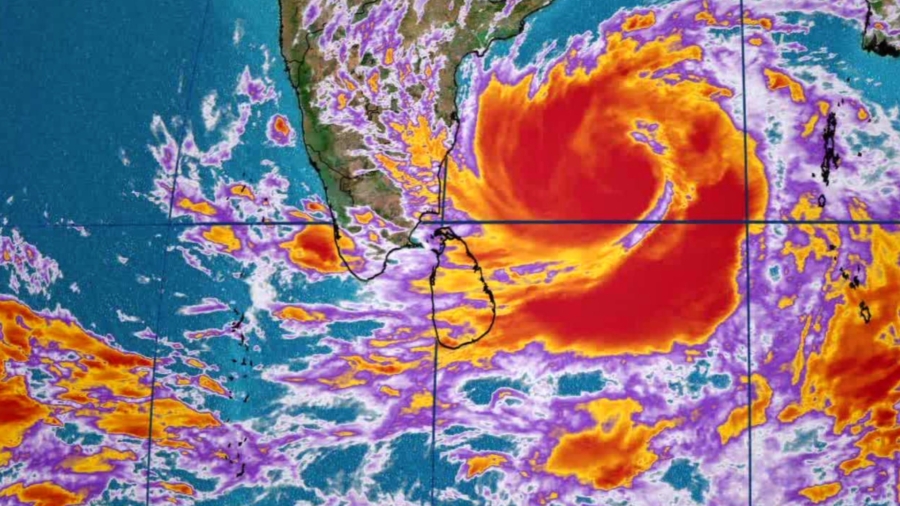A powerful cyclone equivalent to the strength of a strong Category 4 Atlantic hurricane or a super typhoon in the West Pacific is heading toward the India-Bangladesh border. On May 18, the storm became the strongest ever recorded within the Bay of Bengal.
India and Bangladesh ordered more than two million residents to prepare to evacuate Tuesday as Super Cyclone Amphan approached the countries’ southern coasts.
“We will evacuate up to 2.2 million and try to keep casualties at zero,” junior disaster management minister Enamur Rahman told AFP.
“The district administration in 19 most vulnerable southwestern coastal districts have been asked to take all preparedness to save lives,” said Shah Kamal, secretary of the Ministry of Disaster Management and Relief.
Cyclone Amphan intensified with sustained wind speeds of up to 165 miles per hour (270 kilometers per hour) on Monday evening, according to data from the U.S. Joint Typhoon Warning Center.
However, the powerful storm is likely to weaken into an “extremely severe storm” during the next six hours, according to the Indian Meteorological Department (IMD). The super cyclone is expected to make landfall on the India-Bangladesh border on Wednesday evening, by which time it is expected to have the strength of a Category 3 hurricane.

Cyclone Amphan is very likely to follow the path north-northeastwards across the northwest Bay of Bengal and cross West Bengal-Bangladesh coasts between Digha (West Bengal) and Hatiya Islands near the Sundarbans during the afternoon-evening of May 20, according to IMD. The storm will hit as a “very severe cyclonic storm” with a maximum sustained wind speed of 96-102 mph (155-165 kph) gusting to 112 mph (180 kph).
A cyclone warning has been set for the West Bengal and north Odisha coasts in eastern India as of Tuesday morning and the states are currently on a “high alert.”
“A total of 37 teams have been deployed by NDRF (Indian National Disaster Response Force) in West Bengal and Odisha, out of which 20 teams are actively deployed and 17 are on standby in the two states,” NDRF director SN Pradhan said on Monday during a video message, The New Indian Express reported.
“Evacuations are necessary,” warned Mrutyunjay Mohapatra, India’s meteorological chief, pointing out that tidal waves could move 25 kilometers (15 miles) inland along the many rivers that crisscross the Bengal delta.
The storm is bringing the potential for major destruction and upheaval in the two countries that are still battling the CCP (Chinese Communist Party) virus, a novel coronavirus that originated in China and has since caused a global pandemic.
“It [Amphan] is a dual challenge as [the] cyclone is striking in [the] time of COVID-19 and we are facing a double challenge,” Pradhan said.
“The awareness drive being undertaken by NDRF teams in these areas is accordingly tailored to inform the locals about the cyclone and also the coronavirus,” he added.

Debasis Shyamal, a fisherman in Digha, said evacuations had yet to start, but people were staying indoors. “We are mentally prepared for the cyclone, but there are some concerns about social distancing,” he said.
Cyclone Amphan is the second super cyclone on record that has formed over the Bay of Bengal, said Mohapatra. The first was a devastating 1999 cyclone in Odisha state that left nearly 10,000 people dead.
CCP Virus Pandemic
India reported 101,139 confirmed CCP virus infections on Tuesday morning, according to Johns Hopkins University, with Monday recording its largest single-day surge yet with a total of 5,242 new cases. Total deaths rose by 134 to 3,163.

India’s death rate is less than that of some other big countries, at 3 percent, compared with about 6 percent for the United States, where some 89,000 people have died, and 14 percent for Britain.
Meanwhile, Bangladesh’s infection count is rapidly rising, with more than 1,300 new cases on Sunday, its biggest rise yet. In total, the country has recorded 23,870 confirmed infections, according to Johns Hopkins.
Tackling both disasters at once will be challenging for the two governments, especially if they attempt to maintain social distancing in packed evacuation centers and emergency shelters.
Cyclone Amphan could also bring heavy rains to the world’s largest refugee camp in Cox’s Bazar, where almost a million Rohingya refugees live after fleeing violence in Myanmar’s Rakhine state.

The first known COVID-19 cases were confirmed in the camp last week and with the storm now imminent, the two disasters could make for a devastating combination.
One human rights advocate said that a virus outbreak in the camp would be a “nightmare scenario.”
“The prevalence of underlying health conditions among refugees and the deteriorating sanitary conditions sure to come with the looming monsoon and flooding season make for a witch’s brew of conditions in which the virus is sure to thrive,” said Daniel P. Sullivan, who works for the U.S.-based organization Refugees International.
CNN Wire and The Associated Press contributed to this report.

